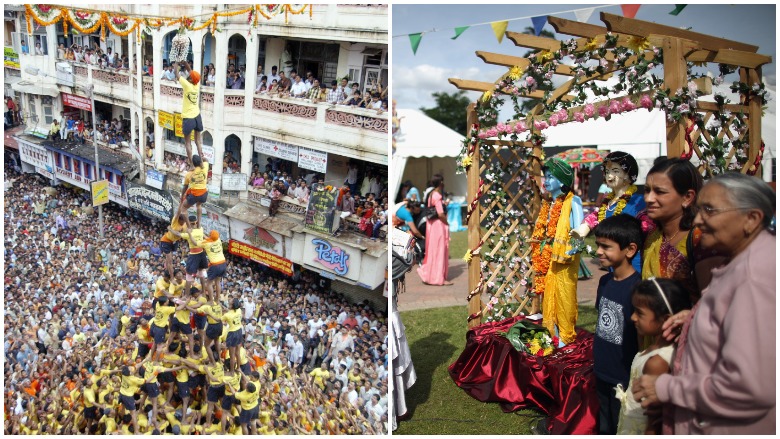
Getty Statues being painted of the Hindu God, Lord Krishna.
Krishna Janmashtami is a religious festival on which Hindus celebrate the birth of Lord Krishna. This year, celebrations will take place on August 11-12 in 2020, although coronavirus concerns have put a damper on the typical public celebrations.
Janmashtami, also called “Gokulashtami” and “Shrikrishna Jayanti,” will be the 5247th Birth Anniversary of Lord Krishna. The biggest celebrations usually take place in India, although the festival is celebrated by Hindu devotees in places all over the globe.
According to the Indian Express, the purpose of the festival is to “promote goodwill and the victory of good over evil” and celebrate togetherness.
Here’s what you need to know:
1. What Is The Story Behind Krishna Janmashtami?
The festival celebrates Lord Krishna’s birthday, according to the Hindustan Times and the history of his escape and rescue from an evil king.
According to the history, Princess Devaki and Vasudeva were married, but were also given the prophecy that the couple’s eighth son would cause the downfall of King Kansa, who was also Devaki’s brother. Krishna, the eighth son, was born in the Bhadrapada month (between August and September) on the “eighth day of the dark fortnight.”
When Kansa heard the prophecy, he imprisoned both Devaki and Vasudeva, and killed their first six children. Vasudeva rescued his son and gave him to another couple, Nand Baba and Yashodha in a different region. When Vasudeva returned to Mathura, he gave the king a baby girl. Although the king attempted to kill the baby, she transformed, becoming the Goddes Durga and telling him his fate.
2. Who is Krishna?
Krishna is a Hindu god who has been worshipped since 5th century B.C.E., according to an Ancient History Encyclopedia. In addition to Janmashtami, Krishna is also celebrated during the festival of Puri, which involves a chariot festival commemorating an attempt to convince an older Krishna to return to the town where he was hidden from the evil king.
Krishna appeared both as a god disguised as human and as a prince pretending to be a commoner. The young Krishna is described as mischievous and adventurous; he killed an ogress, giant bull, giant snake and the king of horses. He was also credited as being a demon killer and of lifting a mountain to save people from a flood. However, the article states that his disguises “hint at Krishna’s dual purpose as the punisher of human deeds but also as a bringer of enlightenment.”
Krishna is usually portrayed with long black hair and dark black or blue skin, hence the blue body paint used during festivals; he is also usually depicted wearing a yellow robe, a peacock feather in his hair and playing a flute. He sometimes also has a club and/or with cows, as a nod to his days being a cowherd.
3. How Is The Festival Celebrated?
Indian Express reported that the holiday is celebrated by fasting, singing devotional songs, cooking sweet treats and maintaining a vigil, along with several other rituals and actions. After the fast is broken, idols of Lord Krishna are cleaned, given new clothes and adorned with new ornaments and placed in a cradle. Then, women often draw tiny footprints leading a trail to symbolize Krishna’s journey home.
The holiday is mainly marked by two major events, dahi handi and puja. “Puja” is the fast, which is supposed to take place 12:05 a.m. on August 11 to 12:48 a.m. on August 12, according to India.com. (Those celebrating outside of India may need to adjust their celebration times).
“Dahi handi” is a celebration of one of Baby Krishna’s favorite foods, makkhan, which is white butter, curd and milk. On the festival, people build a human pyramid and a young boy is sent to break a 20-foot-high pot filled with “makkhan,” the Hindustan Times reported.
4. Where Is The Festival Celebrated?

GettyA Janmashtami celebration in India (left) and the largest celebration outside of India in Watford, England (right).
The Indian Express reported that the festival is celebrated in Mathura, where Krishna was said to be born. It is also celebrated in parts of Gujarat, Rajasthan, and in India’s northeastern states, such as Assam and Manipur.
However, the festival is also celebrated in other parts of the country, such as Watford, England, which boasts the largest Janmashtami outside of India. In 2011, nearly 60,000 pilgrims were expected to show up, BBC reported. That celebration came with the opening of a nonprofit Ahimsa Dairy Foundation and worship of cows, which are considered sacred symbols of peace and prosperity in Hindu culture.
It is also celebrated in kitchens! Sweet treats are a prominent feature of the holiday. Treats, according to Spoon University, include Gole ki Barfi, a combination of desiccated coconut, mawa and sugar; kheer, a mix of milk, sugar and dry fruits with other options; meehi mathri, a unsalted mathri fo refined flour that was soaked in sugar syrup; and Shrikhand, made with yogurt, sugar, cardamom powder and saffron.
5. What Celebrations Are Planned During The Pandemic?
According to the Indian Express, the celebration of the festival will be smaller because of the coronavirus pandemic. Moreover, it is highly unlikely that the typical large public celebrations will take place anywhere in the country.
DNA India reported that the Mathura Administration forbade public events from behind held in the region due to coronavirus concerns and the Krishna Janmabhoomi temple would be closed from August 10-13.
However, many of the activities can still be carried out at home, such as praying, fasting, cooking and rituals with the idols. Children can also reportedly dress up as Krishna with blue paint, yellow robes and other adornments, help cook the festival’s famously sweet treats or craft their own “Krishna” peacock feathers.
READ NEXT: Canada’s Milne Ice Shelf Collapsed After Record-High Arctic Temps



